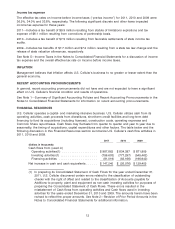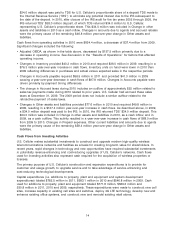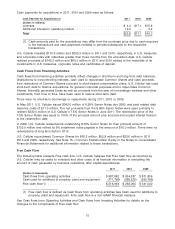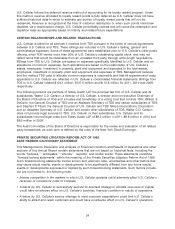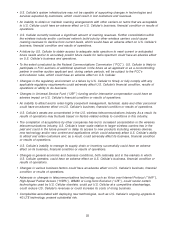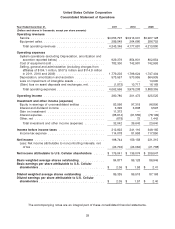US Cellular 2011 Annual Report Download - page 29
Download and view the complete annual report
Please find page 29 of the 2011 US Cellular annual report below. You can navigate through the pages in the report by either clicking on the pages listed below, or by using the keyword search tool below to find specific information within the annual report.
groupings of licenses which, because they were not being utilized and, therefore, were not expected to
generate cash flows from operating activities in the foreseeable future, were considered separate units of
accounting for purposes of impairment testing. The change in units of accounting between November 1,
2011 and November 1, 2010 reflects additional network build-out.
Developed operating market licenses (‘‘built licenses’’)
U.S. Cellular applies the build-out method to estimate the fair values of built licenses. The most
significant assumptions applied for purposes of the November 1, 2011 and 2010 licenses impairment
assessments were as follows:
November 1, November 1,
Key assumptions 2011 2010
Build-out period ................................. 7 years 7 years
Discount rate ................................... 9.0% 9.0%
Long-term EBITDA margin ......................... 32.2% 32.1%
Long-term capital expenditure requirement (as a % of service
revenue) ..................................... 13.0% 12.0%
Long-term service revenue growth rate ................ 2.0% 2.0%
Customer penetration rates ......................... 11-16% 12-17%
The discount rate used in the valuation of licenses is less than the discount rate used in the valuation of
reporting units for purposes of goodwill impairment testing. That is because the discount rate used for
licenses does not include a company-specific risk premium as a wireless license would not be subject to
such risk.
The discount rate is the most significant assumption used in the build-out method. The discount rate is
estimated based on the overall risk-free interest rate adjusted for industry participant information, such as
a typical capital structure (i.e., debt-equity ratio), the after-tax cost of debt and the cost of equity. The
cost of equity takes into consideration the average risk specific to individual market participants.
The results of the licenses impairment test at November 1, 2011 did not result in the recognition of a loss
on impairment. Given that the fair values of the licenses exceed their respective carrying values, the
discount rate would have to increase to a range of 9.1% to 9.9% to yield estimated fair values of licenses
in the respective units of accounting that equal their respective carrying values at November 1, 2011.
Non-operating market licenses (‘‘unbuilt licenses’’)
For purposes of performing impairment testing of unbuilt licenses, U.S. Cellular prepares estimates of fair
value by reference to prices paid in recent auctions and market transactions where available. If such
information is not available, the fair value of the unbuilt licenses is assumed to have changed by the
same percentage, and in the same direction, that the fair value of built licenses measured using the
build-out method changed during the period. There was no impairment loss recognized related to unbuilt
licenses as a result of the November 1, 2011 licenses impairment test.
21



